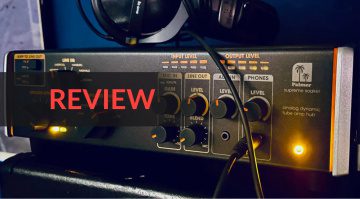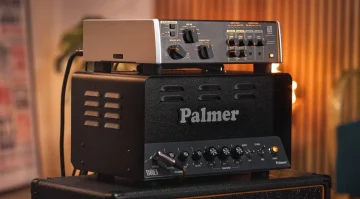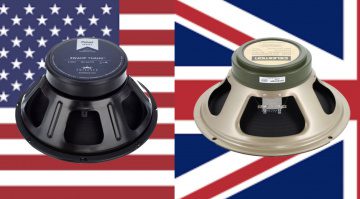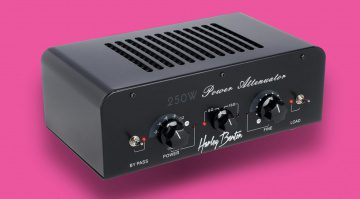Palmer Supreme Soaker Review: A tube amp hub for the masses
Only just announced at NAMM, now the thing is here in my home studio – the Palmer Supreme Soaker. Let’s see what sets the Supreme Soaker apart from other power reducers and what you can expect from a “tube amp hub”.
Palmer Supreme Soaker – The Highlights
- Reactive attenuator for up to 150 watts of tube power (for 8 and 16 ohms)
- Five presets for analog speaker simulations
- Speaker tone control for connected cabinets
- Microphone/line input for additional miked guitar cabinet
- Stereo FX loop
- Amplifier protection circuit with permanent payload
- completely analog
Intro: Design and processing
The mailman wasn’t too pleased with delivering such a heavy package. This thing has weight! In addition to the Palmer Supreme Soaker itself, there is a small quick start guide and one of the easiest panels to understand I have ever used on any guitar equipment.
The design of the Palmer Supreme Soaker is based on the classic studio and hi-fi aesthetics of the 1970s and 1980s. Clear layout, easy-to-read descriptions, and high-quality-looking sockets.
I am slightly surprised about the quality of the included 9V power supply unit, or lack thereof. Even though the Supreme Soaker only needs a small amount of power, I would have preferred a slightly higher-quality cable and power supply unit.
Palmer Supreme Soaker: Technical features and functions
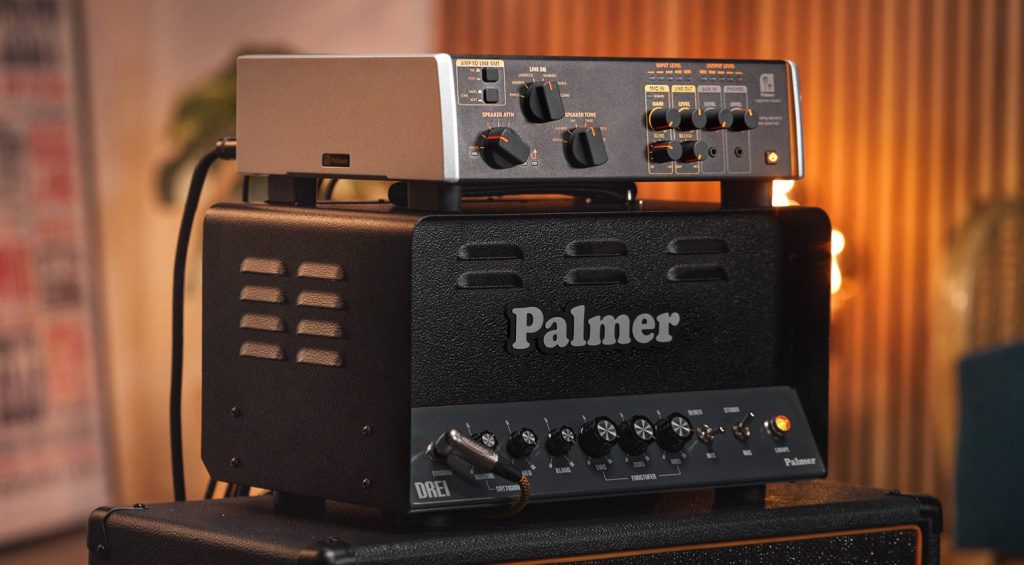
The Supreme Soaker goes far beyond a typical load box such as the Palmer PDI-06. Its approach is unique because it combines an attenuator with analog speaker simulations.
There are three large rotary controls on the front panel: Speaker Attenuation, Line EQ, and Speaker Tone. The “Speaker Attn” pot regulates the load absorption of the load box in stages (Full Attenuation = cabinet silent).
Line EQ and Speaker Tone
There are five possible Line EQ settings: Memphis, Liverpool, Hamburg, Nashville, and Helsinki. In addition, the “Speaker Tone” control can be used to set different speaker voicings.
These are also transmitted to the connected cabinet when the Amp to Line Out switch is set to “Pre”. Switching the speaker, so to speak. Headphone output, aux in, and amp to line out settings round off the front panel.
Palmer Supreme Soaker – I/O
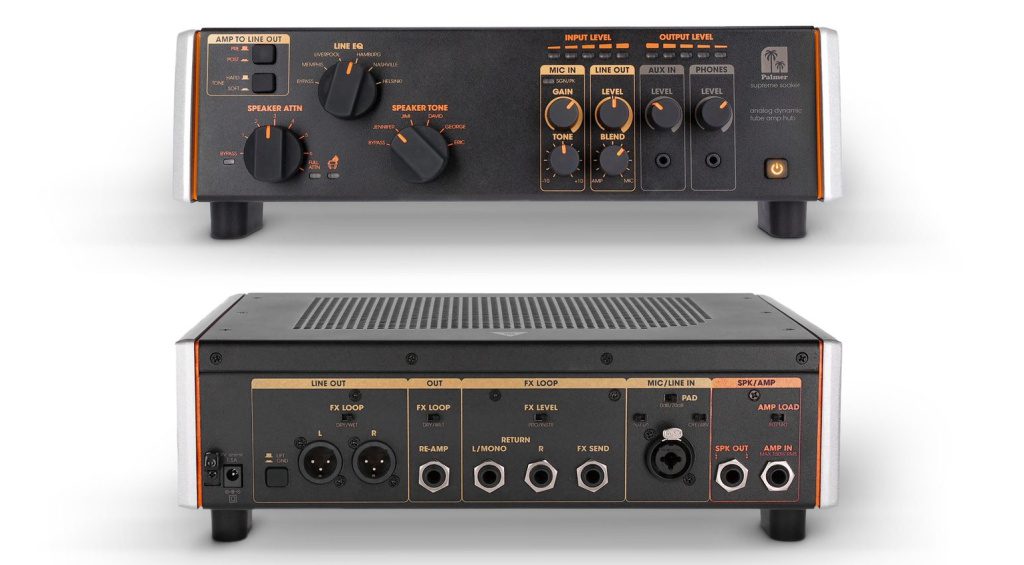
The rear also has a pleasantly straightforward and “handy” design. Amp In, Speaker Out, Mic In, Stereo FX Loop, Reamp, and Line Out are available. There are also a few smaller switches that allow you to choose between 8- and 16-ohm setups, for instance.
The 9V connection looks a bit out of place; with such a heavy and high-quality device, you would expect fat plugs with textile cables.
The Supreme Soaker in use
The simple design of the connections and the logical structure of the functions make setting up the Supreme Soaker just as easy. First, the amp and cabinet are connected to the soaker with speaker cables, then you connect the power supply, and you’re basically done. If you want to go deeper, you can connect pedal effects directly into the FX loop or even connect a microphone to feed the cabinet sound into the room.
In my case, I initially connected the Supreme Soaker to a Laney Lionheart tube amp with a closed 2×12 cabinet with Celestion Greenbacks serving as the cabinet. The FX loop contains a Walrus Audio ARP 87 Delay and the Slötvå Multi Texture Reverb, also from Walrus.
Soundcheck, part 1: Attenuator, but safe
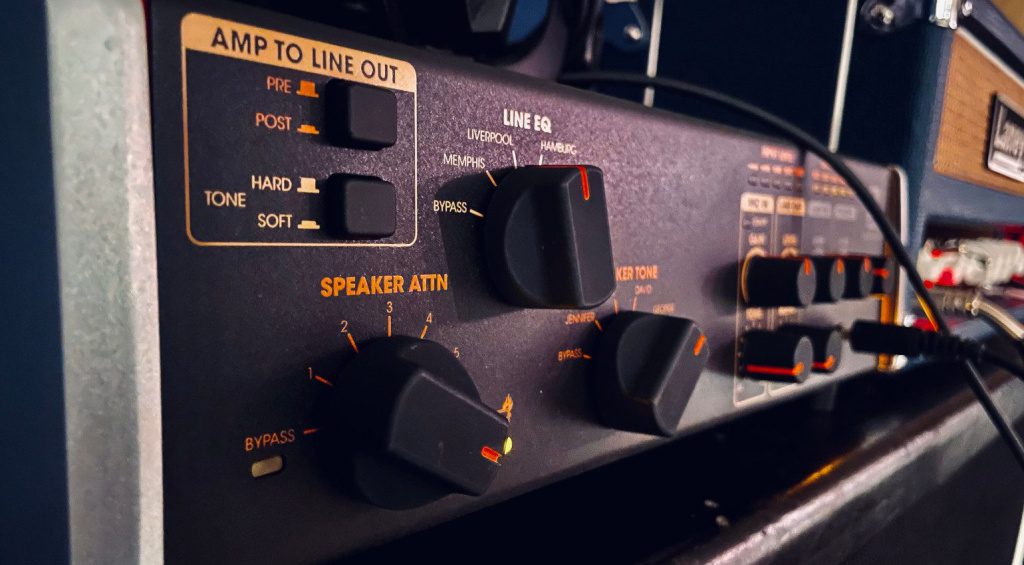
By their very nature, tube amplifiers tend to be somewhat finicky devices. Things can quickly get dicey, especially when the necessary load is not attached to the amp. With the Palmer Supreme Soaker, you no longer have to worry about this. The permanent payload prevents any damage to the amp.
The volume problem cannot be dismissed, either. Even my rather low-powered Laney needs to be so loud to reach its sweet spot that I can’t play next to it for prolonged practice sessions. The primary aim of an attenuator like the Supreme Soaker, therefore, is to maintain the amp’s dynamics and playability with a good sound But at a lower, more practical volume.
The Palmer Supreme Soaker accomplishes this task effortlessly: the amp level can be reduced to a whisper without any noticeable change in feel or dynamics. Of course, the subjective listening experience is always compromised at lower volumes. But the way the Palmer takes the juice and reduces the volume is fabulous.
Soundcheck, part 2: Line EQ
Until now, the sound of my amp was still the sound of my amp – if you know what I mean. Now, however, the truly unique features of the Supreme Soaker come into play, and things get exciting. The analog line EQ allows you to activate the various analog speaker simulations of the Supreme Soaker. The ability to quickly change between the cab sounds is a lot of fun and opens up many possibilities.
For me, “Liverpool” and “Memphis” seemed a little softer, warmer, and suitable for clean sounds. Personally, I like the sonic character of “Helsinki” and “Hamburg” more, especially with distorted sounds. “Nashville” is somewhere in the middle – but subjective impressions certainly vary here.
In terms of sound quality, the Supreme Soaker makes a strong impression. Without interfering too much with the basic character of the setup, subtle nuances can be enhanced or changed. Nice for tone nerds, and at the same time so clear that it is quick and easy to use even for down-to-earth tube amp fans (“set-and-forget”).
Soundcheck, part 3: Speaker tone
Now it’s getting exciting. While I did all the previous sound tests through the line out, the amp to line out switch is now flipped and set to “Pre”. This means that the Palmer Supreme Soaker will drive the cabinet connected to it and, depending on the setting, provide the cabinet with different speaker sounds.
The different sound options are labeled with very telling first names : Jennifer, Jimi, David, George, and Eric. Each one is a different set of settings in the line EQ. It’s just as if you were switching the speakers in your own cabinet while playing. I don’t know how, but Palmer has built something really cool here!
What else is possible?
The Palmer Supreme Soaker is far more than just a simple attenuator – the term “tube amplifier hub” is apt. In addition to the Line EQ and Speaker Tone settings, other gimmicks can be realized: I used the mic input on the back to include a room mic and mixed that into the signal.
This gives me a combination of line EQ and the actual cabinet plus room sound. Nerdy? Yes. But nice and handy. The integrated FX loop is certainly worth mentioning, especially for lovers of classic tube amps. Thanks to the stereo circuit, you can feed the Soaker stereo effects.
Conclusion on the Palmer Supreme Soaker
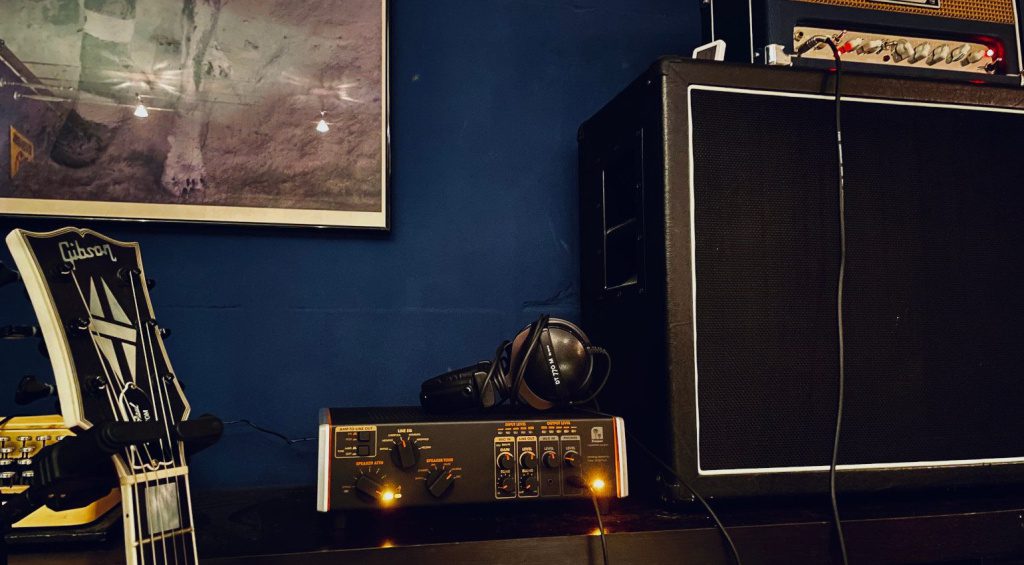
My review period with the Palmer Supreme Soaker was (unfortunately) limited, and I would have liked to run a whole armada of tube amps and cabinets through it.
The many options are easy to understand (even by me), the build quality is excellent, and the sounds are first-class. I would have liked the headphone output to be 6.35 mm, but 3.5 mm is ok for most purposes.
I only used the mic input for to get a full picture for this review. Usually, I’m not one for sound designing a guitar sound through room mics and other esoteric measures. However, the Supreme Soaker does one thing better than any digital modeler I have used: It got me playing guitar. I was able to get the nastiest, most tube driven sounds out if my amp, at neighbor- and family-friendly volumes.
It’s the whole package that makes the difference
With the Supreme Soaker, Palmer has brought a real innovation onto the market. It’s easy to use, it sounds great, and it brings a lot of well-thought-out features to the table. No menus, no apps, no registration of any software: the Supreme Soaker is set up and is completely ready for use within seconds.
Want to try it out for yourself? You can get the Palmer Supreme Soaker here at Thomann*.

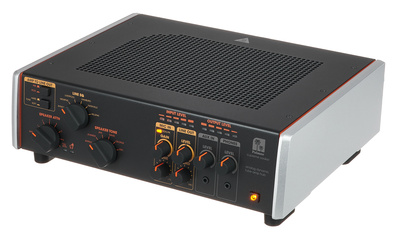
Pros and Cons for the Palmer Supreme Soaker
Pros
- Tube sound at room volume
- Analog speaker simulations of the highest quality
- Additional miking for cabinets
- stereo FX loop
- Completely analog setup
- Safe handling of the amp thanks to permanent payload
- ingenious retro design
Cons
- 9V power supply could have been of higher quality
- I would prefer a 6.35mm headphone output
- Triggers G.A.S. in relation to tube amps that are “actually too loud”!
More on the Tube Amp Hub
- Product Page
- More from Palmer at Gearnews
- Palmer Attenuator at Thomann*
Originally published on Gearnews.de by Jan Rotring. Translation by Julian Schmauch.
* This post contains affiliate links and/or widgets. When you buy a product via our affiliate partner, we receive a small commission that helps support what we do. Don’t worry, you pay the same price. Thanks for your support!

 4,4 / 5,0 |
4,4 / 5,0 | 
